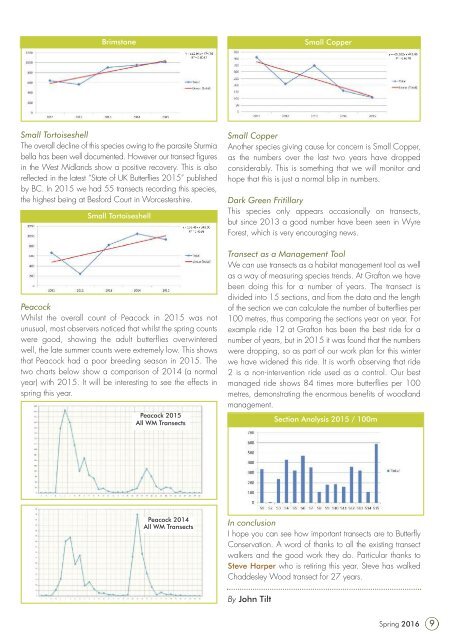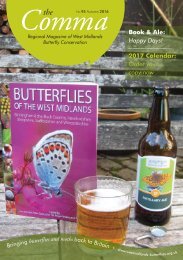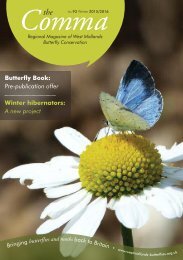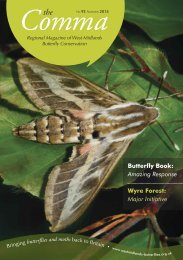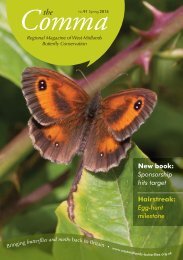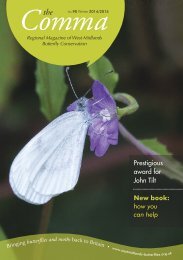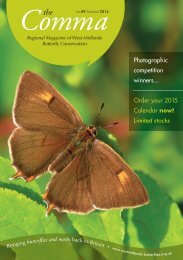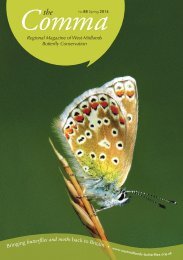Comma No94 Spring 2016
32 page Butterfly Magazine designed for the West Midlands branch of Butterfly Conservation
32 page Butterfly Magazine designed for the West Midlands branch of Butterfly Conservation
Create successful ePaper yourself
Turn your PDF publications into a flip-book with our unique Google optimized e-Paper software.
Brimstone<br />
Small Copper<br />
Small Tortoiseshell<br />
The overall decline of this species owing to the parasite Sturmia<br />
bella has been well documented. However our transect figures<br />
in the West Midlands show a positive recovery. This is also<br />
reflected in the latest “State of UK Butterflies 2015” published<br />
by BC. In 2015 we had 55 transects recording this species,<br />
the highest being at Besford Court in Worcestershire.<br />
Small Tortoiseshell<br />
Peacock<br />
Whilst the overall count of Peacock in 2015 was not<br />
unusual, most observers noticed that whilst the spring counts<br />
were good, showing the adult butterflies overwintered<br />
well, the late summer counts were extremely low. This shows<br />
that Peacock had a poor breeding season in 2015. The<br />
two charts below show a comparison of 2014 (a normal<br />
year) with 2015. It will be interesting to see the effects in<br />
spring this year.<br />
Peacock 2015<br />
All WM Transects<br />
Small Copper<br />
Another species giving cause for concern is Small Copper,<br />
as the numbers over the last two years have dropped<br />
considerably. This is something that we will monitor and<br />
hope that this is just a normal blip in numbers.<br />
Dark Green Fritillary<br />
This species only appears occasionally on transects,<br />
but since 2013 a good number have been seen in Wyre<br />
Forest, which is very encouraging news.<br />
Transect as a Management Tool<br />
We can use transects as a habitat management tool as well<br />
as a way of measuring species trends. At Grafton we have<br />
been doing this for a number of years. The transect is<br />
divided into 15 sections, and from the data and the length<br />
of the section we can calculate the number of butterflies per<br />
100 metres, thus comparing the sections year on year. For<br />
example ride 12 at Grafton has been the best ride for a<br />
number of years, but in 2015 it was found that the numbers<br />
were dropping, so as part of our work plan for this winter<br />
we have widened this ride. It is worth observing that ride<br />
2 is a non-intervention ride used as a control. Our best<br />
managed ride shows 84 times more butterflies per 100<br />
metres, demonstrating the enormous benefits of woodland<br />
management.<br />
Section Analysis 2015 / 100m<br />
Peacock 2014<br />
All WM Transects<br />
In conclusion<br />
I hope you can see how important transects are to Butterfly<br />
Conservation. A word of thanks to all the existing transect<br />
walkers and the good work they do. Particular thanks to<br />
Steve Harper who is retiring this year. Steve has walked<br />
Chaddesley Wood transect for 27 years.<br />
By John Tilt<br />
<strong>Spring</strong> <strong>2016</strong> 9


